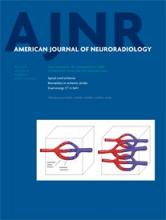We read with interest the article by Mitchell et al1 of 4 cases of ectopic posterior pituitary lobe and periventricular heterotopia and the letter about this study from Bergson et al.2 The authors suggested that an underlying genetic abnormality or a common mechanism or both were the most likely explanation for the findings. Bergson et al also suggested that it might be a complex form of a septo-optic dysplasia. We report a case that shares similar findings with those1,2 but is also associated with corpus callosum dysgenesis, and we discuss the common underlying mechanism.
A 19-year-old man with a history of panhypopituitarism and intellectual and motor disability came to our department for MR imaging. He did not have a history of seizures except from a febrile convulsion episode at 3 years of age. The ophthalmologic examination was positive for a pale left optic disc. MR imaging revealed an ectopic posterior pituitary lobe, a hypoplastic pituitary gland, corpus callosum dysgenesis, and a hypoplastic optic chiasm on the T1-weighted sagittal and coronal images (Fig 1A–C). Absence or a marked hypoplasia of the pituitary stalk was detected incidentally on coronal images. Coronal 3D T1-weighted, axial T2-weighted, and FLAIR images showed right frontal cortical dysplasia (defined as polymicrogyria) and a strip of ectopic gray matter (defined as subcortical heterotopia) extending from the head of the right caudate nuclei to the orbitofrontal lobe. In addition, subependymal nodular heterotopia on the frontal, temporal, and occipital horns of the lateral ventricles bilaterally and a hypoplastic left optic nerve with a hypoplastic chiasm were detected on 3D T1-weighted coronal images also (Fig 2A–D).
A, Sagittal T1-weighted image shows a hyperintensity corresponding to an ectopic posterior pituitary lobe located on the floor of the third ventricle (white arrow) with corpus callosum dysgenesis (star). The pituitary gland is small, and the stalk is not visualized incidentally. B, Coronal T1-weighted image shows hyperintensity corresponding to an ectopic posterior pituitary lobe that is located on the floor of the third ventricle (white arrow). C, Coronal T1-weighted image shows hypoplasia of the left optic nerve (arrowhead).
A and B, Axial T2-weighted and FLAIR images show cortical dysplasia (polymicrogyria) in the left orbitofrontal lobe (thin arrow). C, Coronal 3D T1-weighted image shows left subcortical heterotopia (thick arrow). D, Coronal 3D T1-weighted image shows subependymal nodular heterotopia near the lateral ventricle (arrowheads).
Neuronal migration is essential for brain development and normal functioning of the nervous system. Neuronal migration disorders (NMD) are a heterogeneous group of disorders that share similar underlying mechanisms such as an error in neuronal migration during neurogenesis. Lissencephaly (smooth brain), heterotopia, polymicrogyria, and schizencephaly are the most common NMD. Subcortical and subependymal nodular heterotopias with polymicrogyria were the examples of NMD in our case as well as in the cases reported by the authors.1,2 These cases were different from septo-optic dysplasia because of the presence of a septum pellucidum. Another interesting point in our case is corpus callosum dysgenesis, which was detected in another similar case reported previously.3 The corpus callosum is the largest commissure connecting the cerebral hemispheres. Some molecules are secreted by midline glial populations that are involved in attracting and repelling axons so that they cross the midline and form the corpus callosum.4 An abnormal migrational mechanism is also supported by the associations of corpus callosum developmental abnormalities with NMD, such as classic lissencephaly, cobblestone lissencephalies, polymicrogyria, schizencephaly, and heterotopia.4 During the patient's eye examination, retinal thickness was assessed by spectral domain optical coherence tomography. The ganglion cell and inner nuclear layers were thinner than those in the normal population. This size leads to a thinner retinal nerve fiber layer, which follows the optic nerve toward the optical chiasm (Fig 3A–C). This finding was identified as more evidence of the defective migrational mechanism in the physiopathology for this complex condition.
Fundus photography of right (A) and left (B) eyes. The optic disc is hypoplastic in the left eye (white arrow). C, Spectral domain optical coherence tomography analysis reveals thinning of the bilateral retinal nerve fiber layer, more on the left side than the right (red indicates the decrease of the ganglion cells in the retinal nerve fiber layer, star and black arrows).
In conclusion, we agree with the authors and support the hypothesis that these cases may occur with a common mechanism that may be related to an error during neuronal migration in early embryogenesis. These similar clinical and radiologic findings may also indicate an undefined neuronal migration syndrome.
REFERENCES
- © 2015 by American Journal of Neuroradiology















